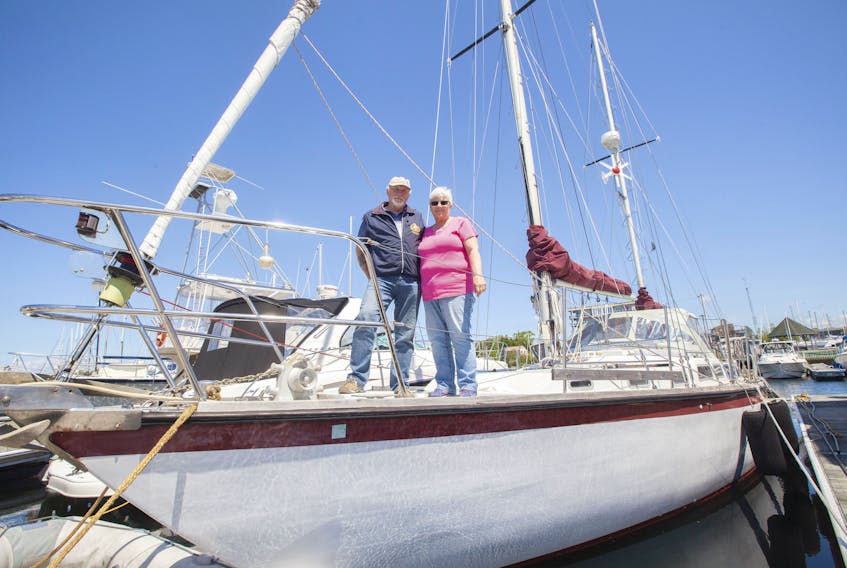While their numbers are small, there are several Atlantic Canadians opting to sell their land-locked properties and live full-time aboard their boat
Waves lap gently against the hull of the Xcelsior II, a 44-foot sailboat sheltered in Wright’s Cove, Nova Scotia, on the eastern shore of the Bedford Basin at the Dartmouth Yacht Club.
Built in Africa, the Xcelsior II has two bedrooms, one in the front of the ship and the other in the back, a kitchen, living area complete with a flat screen TV, two bathrooms and a shower.
When it was first brought to Canada, the Xcelsior II was worth an estimated $440,000.
Ted and Pat Haight snagged a deal, buying her for only $60,000 six years ago.
And now, they call that sailboat their home.
The Haights are members of a seldom-discussed “liveaboard” community in Atlantic Canada: people who choose to live most or all of the year on their boats.
Their numbers are few.
“There are about 300 boats in the yacht club (in Dartmouth) and only about a dozen of us live aboard our boats,” estimates Ted.
Perhaps because of the small size of the liveaboard community, depictions of these people run the gamut from Hollywood’s portrayals of yacht owners as being filthy rich to descriptions of them as eccentric.
The Haights, though, are neither. Just regular working folks.
“I’m a school bus driver and my wife is a monitor,” says Ted. “We pick up and deliver precious cargo during the school year and then we bugger off during the summer.”
It wasn’t always like this for the couple. There was a time when they lived much like every other typical, suburban Canadian family.
“We had a five-bedroom, two-bathroom house in Woodlawn in Dartmouth, a middle-class area,” says Pat. “We had great neighbours, a full garage and a backyard.”
Maintaining that house on its almost half-acre lot, though, was a lot of work.
Ted was in the navy, leaving his wife at home alone, taking care of all of the usual maintenance, for long stretches while he was out to sea. She tired of mowing the lawn and shoveling their long driveway.
Fifteen years ago, the Haights did something about it.
“We sold the house in 2003 and bought a 27-foot sailboat. That was our summer cottage. We would stay there even when our granddaughters came along.”
At first, the couple stayed in apartments during the winter months or house-sat. But the lure of the open seas and warmer climes proved irresistible.
Three years later, in 2006, they set sail and lived aboard that first sailboat for 20 months.
Now, the two 64-year-olds are getting ready to live that adventure again. Once they retire and the summer months draw to a close in Atlantic Canada, the Haights will guide the Xcelsior II out to sea and leave winter behind.
“We will be headed south, leaving on the Labour Day weekend,” said Ted. “It’ll be a five-destination trip along the Eastern Seaboard before we head to the Bahamas … the Caribbean. Then, in mid-April (the following year), we’ll head up along the Gulf Stream and be back in Nova Scotia before the hurricane season.”
That’s roughly the beginning of June.
Pricing a peaceful life at sea
Casting aside the costly investments and maintenance of home and property ownership for a life aboard a sailing boat might seem an appealing endeavour, it does come with its own financial and time costs.
Dartmouth Yacht Club residents Ted and Pat Haight had sold their nearby Dartmouth property in 2003 and purchased a sailboat as a summer cottage. That would start a process that would see them purchase a larger boat they would call home full-time.

With their latest purchase, they still have roughly four more years of payments at $563 per month to pay off the loan they took out to buy the boat. That’s $6,756 per year. Add to that boat insurance at $602 per year and another liability insurance for liveaboards of about $250 annually and those cost alone add up to more than $7,600 every year, not including another $9,000 in annual expenses to live aboard the boat.
Membership in the Dartmouth Yacht Club and fees related to the marina comprise about $3,000 of that extra $9,000 in costs the Haights have to live aboard.
Add to those fees is the cost of regular maintenance.
At the Dartmouth Yacht Club, cleaning the bottom of the boat every year is covered by the membership fee. But other boat owners who get the work done elsewhere can wind up paying hundreds, if not thousands, of dollars depending on the size of the boat and where the cleaning is done.
“If we’re down south, it’ll probably take $1,000 to get the boat cleaned,” said Ted. “If they’ve got two guys working on your boat, they’ll charge $100 per hour.”
A gallon of anti-fouling paint used on the hull of boats costs about $300 per gallon. A sailboat the size of their 44-foot Xcelsior II would need two gallons of this paint to re-do the bottom. Regular boat paint for such things as the deck goes for about $130 per gallon.
“This is a 38-year-old boat and the former owners did not necessarily do the maintenance that was required,” said Ted. “I’m in the middle of re-doing the upper deck because the former owners painted it to pretty it up for sale and used house paint.
“I’ve got 44 feet of deck to scrape off and sand down and re-paint,” he said.
Then, there’s the smelly side of life. Dealing with sewage. Marinas typically have pump-out stations to take care of this right on the docks.
“We have a $3,000-feature on board that’s a sewage treatment plant so we can dump overboard,” he adds.
Pros and cons of a boating life
Living aboard a sailboat or a yacht is a dream for many and a nightmare for others.
On the plus side are no property taxes, no lawn to mow or driveway to shovel, no siding or roof to repair. If the neighbours are too noisy, well, those who live aboard can just sail away. On the open water, it’s quiet, often peaceful. The fishing is great.
“When we owned a house, we were tied down,” says Pat. “You’re forever mowing the lawn or, when the wind blows, changing roof tiles or removing a tree that fell on your shed. I hated it.”
Living aboard a boat, though, isn’t all sunshine and smooth sailing either.
In 2006, the Haights were off the coast of Bermuda on a windless day when their boat’s engine died just as a storm was approaching. They were stuck. Dropping a parachute anchor, they were forced to ride it out. On the open water in a storm, their sailboat’s mast was essentially a lightning rod.
“It was a dangerous situation,” admitted Pat.
And living at sea requires you to be resourceful, explains Ted.

The three-burner stove and oven aboard the Xcelsior II use propane and the couple has a 54-litre freezer and a refrigerator that both run on electricity. The diesel engine puts out about 37 horsepower and it, like the boat’s electrical systems, needs to be constantly kept in perfect working order.
“You have to be really handy and mechanically inclined,” says Ted. “When you’re 400 miles out to sea, you’re not going to call CAA … You have to be self-sufficient.”
Living aboard a sailboat is not entirely like living in a house in suburbia or an apartment in the big city. That, though, is part of the attraction.
“It’s got all the comforts of home but less housekeeping,” says Pat.
On the open seas, the Haights fish – and spend quiet evenings with puzzles and colouring books.
“It’s very feasible (for most people) to buy a boat,” she adds. “It’s no different than a house. It’s a floating cottage. It’s a quiet lifestyle.”
But that peaceful lifestyle might change this year. The Haights are getting into music.
Pat, who plays piano, now has a small Yamaha keyboard onboard, and Ted just picked himself up a Gretsch electromatic, hollow-bodied, six-string guitar. It's the same type used by guitarist Brian Setzer, whose rockabilly band the Stray Cats propelled him to fame in the early 1980s.
His plan is to teach himself how to play.
A quiet lifestyle? Maybe not so quiet anymore.









